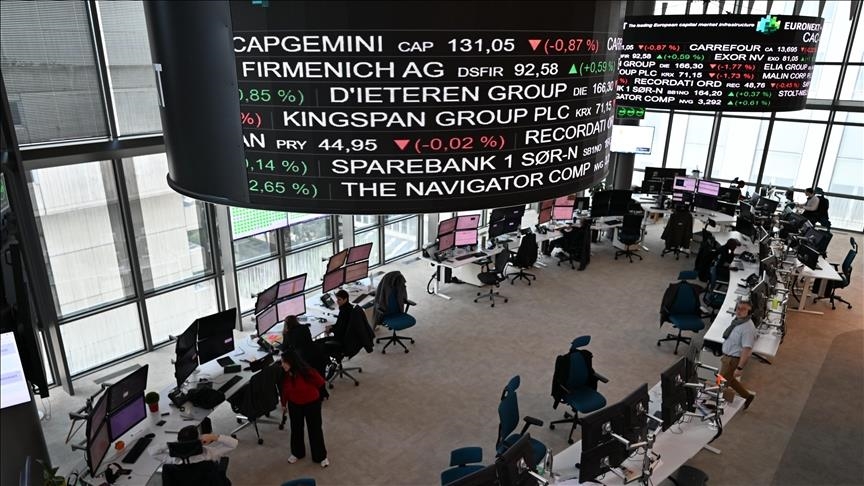Global markets on mixed trend after US inflation rises
US monthly, yearly inflation see highest since January, February, respectively, led by tariffs, prompting Fed to remain cautious before cutting rates

ISTANBUL
Global markets were mixed on Tuesday amid rising US inflation, led by tariffs, while the Fed’s future policy roadmap remains unclear as the bank remains cautious.
The US’ Consumer Price Index (CPI) rose 0.3% on a monthly basis in June, within estimates, but it soared 2.7% on an annual basis, above expectations.
The US’ monthly inflation saw its highest since January and its yearly inflation since February.
The country’s core CPI — excluding energy and food — climbed 0.2% month-on-month and 2.9% year-on-year last month. Markets expected a 0.3% monthly increase and a 3% yearly one. In May, the core CPI rose 0.1% on a monthly basis and 2.8% on a yearly basis.
Analysts say the Fed may hold off on making any cuts with tariff-related risks on the table until the banks gains more clarity on inflation and labor market outlook. The Fed’s likelihood to cut rates in September declined but the possibility of two total rate cuts remains unchanged in the money markets.
All eyes now turn to the Producer Price Index (PPI) data to be announced to seek clues into the course of the US inflation.
Meanwhile, the Fed is facing political pressure amid US President Donald Trump’s calls to lower rates, saying that it would save $1 trillion a year if the bank lowered its rates by 3 points. Trump also said Treasury Secretary Scott Bessent is a candidate that could potentially replace Fed Chair Jerome Powell.
Fed officials remain cautious as tariffs are expected to push inflation upwards in the second half of the year and the core inflation could even reach 3% by the end of the year.
At the same time, the US 10-Year Treasury bond rose to 4.49% amid inflation concerns, while the US Dollar Index increased to 98.6 with growing expectations that the Fed will stay cautious.
The US Dollar Index’s rise pressured gold. The ounce price of gold fell 0.6% on Tuesday to $3,325 but it recovered some of its losses, ending the day at $3,337, while the barrel price of Brent crude oil climbed 0.1% to $68.4.
As for US enterprises, major banks announced their second-quarter earnings.
JPMorgan Chase’s net profit declined 17% in the second quarter and its shares fell around 1%, while Wells Fargo profits climbed 0.6% and its shares declined 5.5%, and Citigroup’s profits increased 25%, while its shares rose nearly 4%.
Nvidia’s shares gained 4% after it said the US government assured the chipmaker over export licenses and plans to continue selling its H20 artificial intelligence (AI) chips to China. The rise in Nvidia shares was reflected positively to the Nasdaq.
On Tuesday, the S&P 500 fell 0.4% and the Dow Jones 0.98%, while the Nasdaq climbed 0.18%. American indexes started Wednesday on a negative course.
Meanwhile, European stock markets had a sell-off on Tuesday as the effect of US tariffs began to rear its head in the region’s economic outlook. Investors focus on the eurozone trade balance data to be announced on Wednesday.
Bank of England (BoE) Governor Andrew Bailey said the International Monetary Fund (IMF) has to play a role to alleviate risky imbalances in the global economy, as whether the EU and the US will reach a deal on tariff remains unclear. Bailey said most of these imbalances stem from China and the US.
The ZEW Economic Sentiment Index — measuring institutional investors’ and analysts’ expectations for the next six months — rose 5.2 points month-on-month to 52.7 in July, signaling positive for the region’s economy and its falling interest rates.
On Tuesday, the FTSE 100 fell 0.66%, the DAX 40 0.42%, the FTSE MIB 30 0.66%, and the CAC 40 0.54%. European indexes started Wednesday on a negative trend.
At the same time, Asian markets remained mixed amid optimism that Nvidia’s AI chip shipments to China may resume, which pushed up tech stocks.
Chinese Vice Premier He Lifeng said the country is boosting its industrial modernizations, which will result in the betterment of the global industry and supply chains.
The Nikkei 225 climbed 0.5% and the Hang Seng Index 0.4% near the close on Tuesday, while the Kospi Index fell 0.8% and the Shanghai Composite Index 0.1%.


